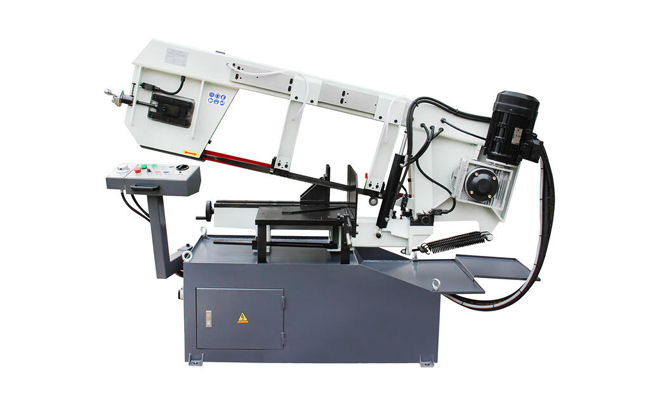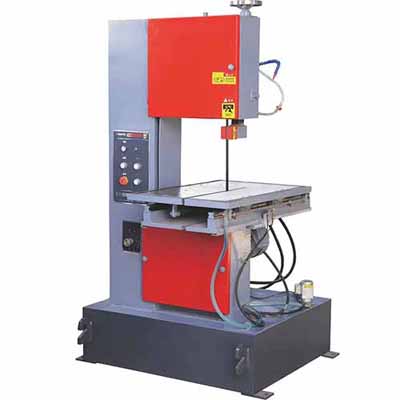VS-400 Vertical Bandsaw
Cutting Capacity :
When it comes to cutting metal, wood, or other materials, bandsaws are among the most efficient tools available. However, choosing between a horizontal bandsaw and a vertical bandsaw can be challenging, especially if you’re unsure about their differences and applications.
we’ll compare horizontal vs. vertical bandsaws, discussing their key features, advantages, disadvantages, and best use cases to help you make an informed decision.
What Is a Horizontal Bandsaw?

A horizontal bandsaw has a blade that runs horizontally, with the workpiece typically clamped in place while the saw blade moves downward to make the cut. These saws are commonly used for cutting metal, pipes, and large stock materials into smaller, more manageable pieces.
Advantages of Horizontal Bandsaws
✔ Ideal for heavy-duty cutting – Perfect for metalworking and industrial applications.
✔ Precision cutting – Provides straight, uniform cuts with minimal effort.
✔ Handles large workpieces – Can cut long bars, tubes, and thick materials efficiently.
✔ Automated operation – Many models feature hydraulic or pneumatic feed systems for consistent cuts.
Disadvantages of Horizontal Bandsaws
✖ Limited versatility – Not ideal for intricate cuts or curves.
✖ Takes up more floor space – Due to their horizontal design, they require a larger workspace.
Best Uses for Horizontal Bandsaws
Metal fabrication (cutting steel, aluminum, etc.)
Pipe and tubing cutting
Stock cutting in industrial settings
What Is a Vertical Bandsaw?

A vertical bandsaw has a blade that runs vertically, allowing the operator to guide the workpiece through the blade by hand or with a table. These saws are highly versatile and commonly used for detailed cuts, curves, and intricate shapes.
Advantages of Vertical Bandsaws
✔ Versatile cutting – Can make straight cuts, curves, and complex shapes.
✔ Better for detailed work – Ideal for woodworking, plastics, and thin metals.
✔ Compact design – Takes up less space compared to horizontal models.
✔ Manual control – Allows for greater precision in artistic or custom cuts.
Disadvantages of Vertical Bandsaws
✖ Less efficient for thick materials – Struggles with very large or heavy workpieces.
✖ Requires more skill – Freehand cutting demands experience for accuracy.
Best Uses for Vertical Bandsaws
Woodworking (cutting curves, shapes, and joinery)
Prototyping and custom fabrication
Thin metal and plastic cutting
| Feature | Horizontal Bandsaw | Vertical Bandsaw |
|---|---|---|
| Blade Orientation | Horizontal | Vertical |
| Best for | Heavy-duty, straight cuts | Detailed, curved cuts |
| Material Handling | Large, thick materials | Smaller, intricate workpieces |
| Automation | Often automated (hydraulic/pneumatic) | Mostly manual |
| Space Requirement | Larger footprint | More compact |
| Skill Level | Easier for repetitive cuts | Requires more skill for precision |
Which Bandsaw Should You Choose?
Choose a Horizontal Bandsaw If:
✅ You primarily cut metal or thick materials.
✅ You need straight, repetitive cuts.
✅ You work in an industrial or heavy-duty setting.
Choose a Vertical Bandsaw If:
✅ You need versatility for curves and intricate designs.
✅ You work with wood, plastics, or thin metals.
✅ You have limited space but need precision cutting.
Both horizontal and vertical bandsaws have unique strengths that make them suitable for different tasks. If your work involves high-volume metal cutting, a horizontal bandsaw is the better choice. However, if you need flexibility for detailed and curved cuts, a vertical bandsaw is the way to go.
By understanding their differences, you can select the right bandsaw for your workshop or industrial needs.
Looking for a Bandsaw?
Check out top-rated brands like Jet, DeWalt, and Grizzly for reliable horizontal and vertical bandsaw options.
Did you find this guide helpful? Share your thoughts in the comments below!
Cutting Capacity :
Cutting Capacity :